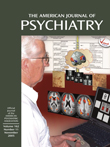Functional Neuroanatomy of Successful Paired Associate Learning in Alzheimer’s Disease
Abstract
OBJECTIVE: The purpose of the study was to develop a strategy for functional imaging of neurodegenerative disorders that overcomes confounds associated with differential performance between patient and comparison groups. METHOD: Functional magnetic resonance imaging was used to examine responses to increasing difficulty of visuospatial paired associate learning in 12 patients with mild probable Alzheimer’s disease and 12 age-matched healthy comparison subjects. Performance was matched across groups by only examining successful encoding and retrieval attempts. Adjustment for task difficulty was made on an individual basis so that the patients with Alzheimer’s disease and the comparison subjects performed at the same relative levels of difficulty. RESULTS: A network of lateral and medial frontoparietal and occipital regions was engaged in all subjects during successful associative learning. As task difficulty increased, blood-oxygen-level-dependent responses increased linearly in occipitoparietal regions during encoding and retrieval. Differential activations in patients with Alzheimer’s disease and comparison subjects were small and were found only when an uncorrected statistical threshold was used. CONCLUSIONS: By controlling for confounds of varying task difficulty and subsequent performance, remarkably similar brain activations were identified during successful paired associate learning in patients with Alzheimer’s disease and in healthy comparison subjects. The study methods provide a useful model for further applications of functional imaging involving cognitive activation paradigms in the study of neuropsychiatric disorders.



